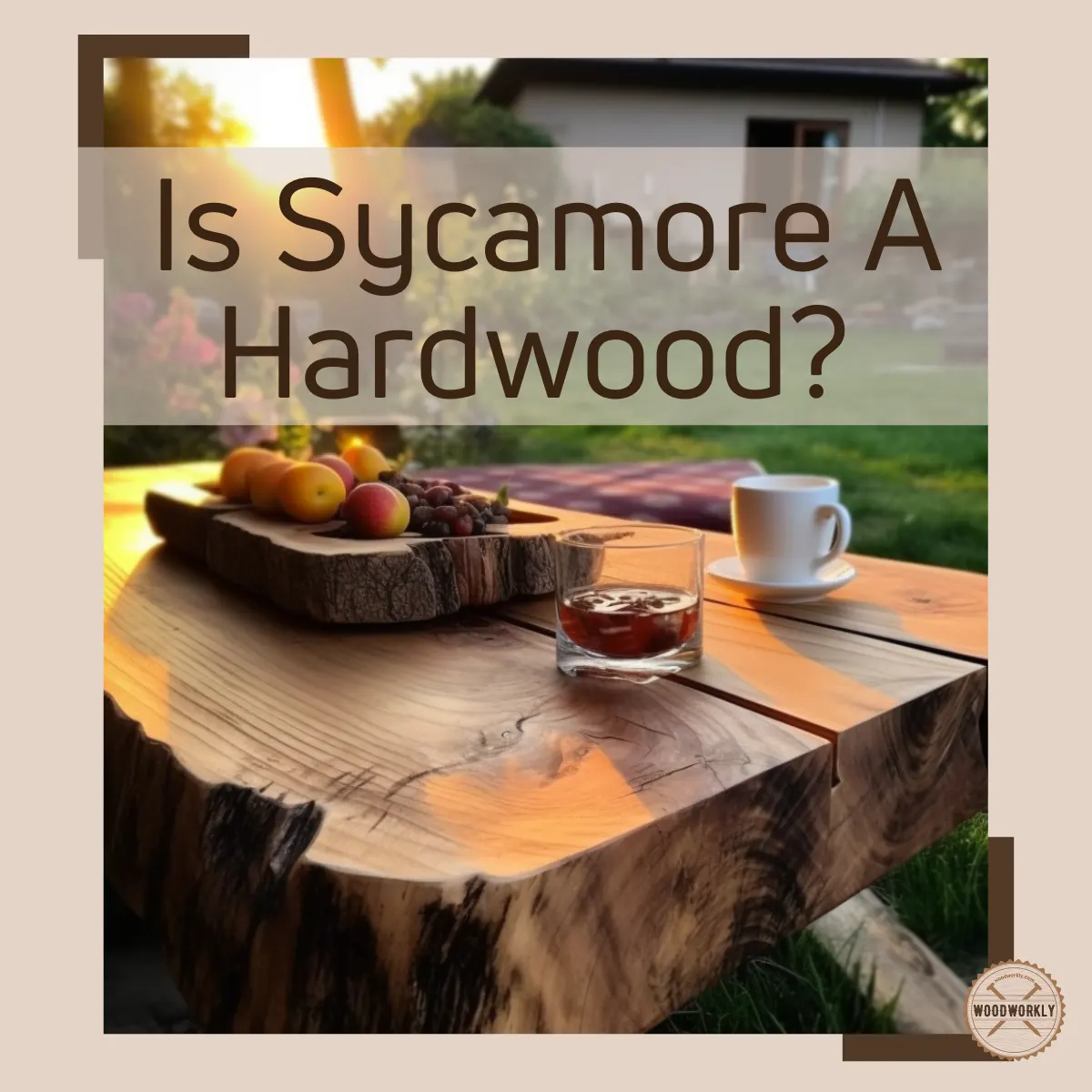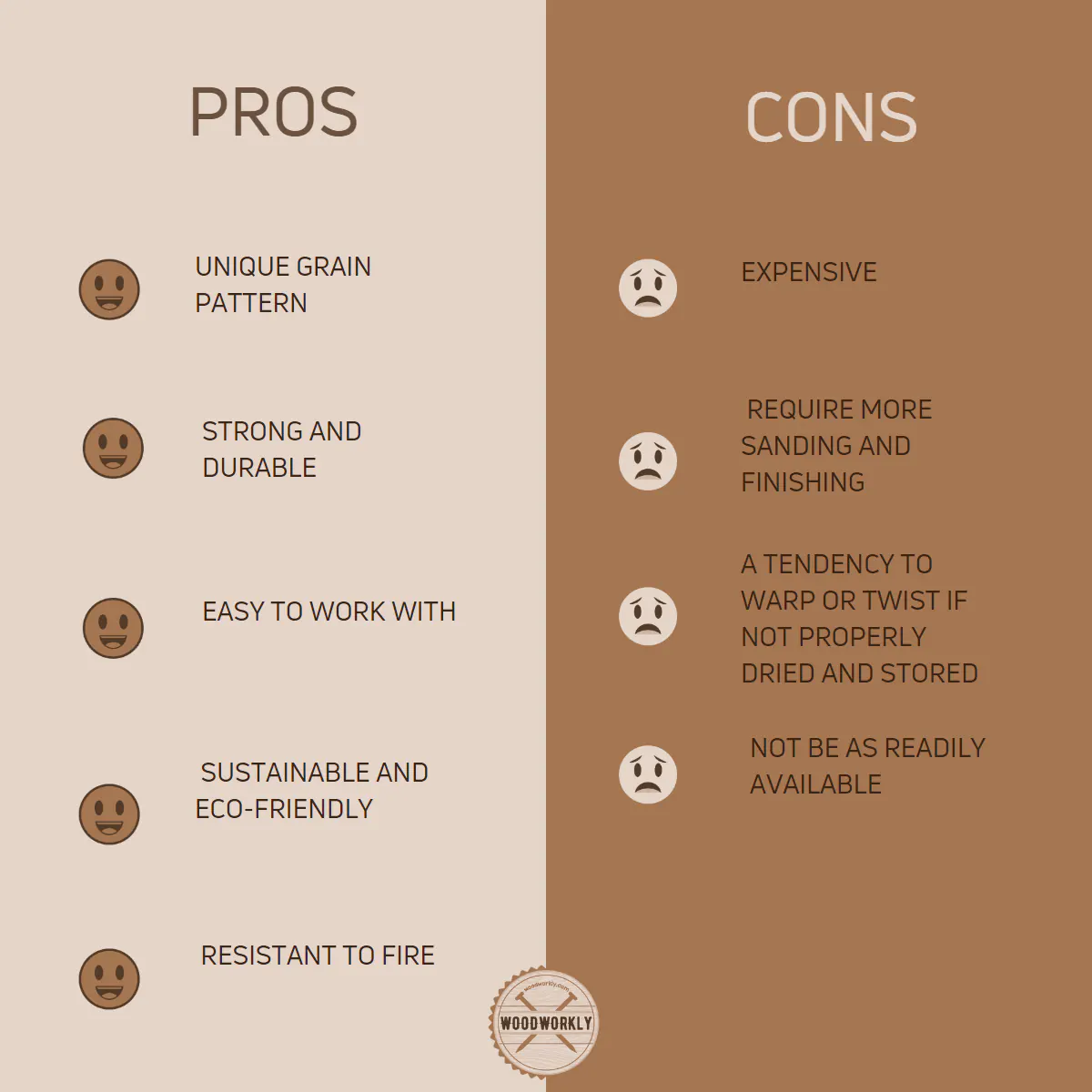Ever looked at a towering Sycamore tree and wondered, “Is that a hardwood?” Dive in as we unravel the intricate world of Sycamore wood!

Sycamore is a popular wood in carving, furniture making, butcher block making, flooring, and many more. It is a fast-growing tree with lots of great qualities.
When using Sycamore for different woodworking projects, I was curious about its hardness.
I’ve done some research and found out, Is Sycamore a Hardwood?
Yes, Sycamore is a hardwood with excellent dimensional stability. It is a domestic hardwood with a hardness rating of 770 lbf (3,425 N) which is higher than most woods. Because of having high hardness and toughness, Sycamore is used for high-end furniture and cabinetry.
But that’s just a quick snapshot and there’s a lot more to know about the hardness of Sycamore just than that!

In this article, I’ll explore is Sycamore a hardwood, and how hard is Sycamore by considering its characteristic qualities compared to other woods and its pros and cons.
Furthermore, I’ll answer some frequently asked questions as well.
So, let’s jump in!

First of all, let;’s have a quick look at what is Sycamore wood?
What is Sycamore Wood?
Sycamore wood is a type of hardwood derived from the Sycamore tree, scientifically known as Platanus occidentalis, and commonly found throughout the eastern United States.
This tree can grow quite tall, ranging between 75 and 120 feet, with a trunk diameter of 3 to 8 feet.
Often referred to as “American Plane” in Europe, the Sycamore tree yields a fine-textured wood that boasts unique characteristics, setting it apart from other hardwoods.
Workability and Applications of Sycamore Wood
In terms of workability, Sycamore is generally easy to work with, be it through hand tools or machine tools.
But it’s not all smooth sailing – the interlocked grain can occasionally pose challenges during surfacing and machining operations.
However, when it comes to turning, gluing, or finishing, Sycamore performs excellently.
Given its versatility, Sycamore wood finds its way into a variety of applications. You’ll often find it in veneer, plywood, interior trim, pallets and crates, flooring, and furniture.
It’s also used in making particleboard, paper (as pulpwood), tool handles, and other turned objects.
Is Sycamore Wood Affordable?
Sycamore wood is generally affordable, although prices can vary depending on the region and how the wood is sold.
For instance, Sycamore is frequently offered in quartersawn boards, which enhances the dimensional stability of the wood but can also increase the cost.

How Hard Is Sycamore?
Sycamore is one of the hardest domestic species in the world, which only seconds to wood types like Hickory.
It is a hardwood with exceptional dimensional stability, toughness, and durability.
The hardness of Sycamore is calculated by the Janka hardness test.
Janka hardness test is calculated by considering the resistance to wear and dent of a particular wood.
If any wood has high resistance against dent and wear, that means its Janka hardness rating is high.
According to the Janka hardness ratings, Sycamore has a hardness rating of 770 lbf (3,425 N) which is harder than most softwoods and some hardwoods as well.
Sycamore comes from a deciduous tree family that loses leaves in winter. It has a diffuse porous structure from small to medium.
Because of being hardwood, tyloses are present in their wood fibers which helps to minimize water absorption and prevent the wood from rotting.

Because of having high hardness and due to the presence of tyloses, Sycamore can be used for outdoor applications.
It has good weather resistance.
Sycamore wood is hard, tough, and durable. It has excellent resistance against cracking and splitting. Therefore, Sycamore is difficult to cut.
Woodworks and furniture made from Sycamore last for years even under harsh environments due to high hardness and resistance against environmental elements.
Due to high hardness, most sawmills don’t quarter saw Sycamore.
It has a beautiful light tan to orange and brown color shades that add unique appearances to your house.
Because of having a significantly high hardness with a beautiful appearance, Sycamore is popular for luxury high-end furniture.
People tend to buy Sycamore furniture because they care about the quality of the wood.

Hardness Of Sycamore Compared to Other Woods
So, let’s have a look at the hardness of Sycamore compared to other wood types to get an idea about how hard it is.
| Wood Species | Hardness value |
| Brazilian Walnut | 3,684 lbf (16,390 N) |
| Red Mahogany, Turpentine | 2,697 lbf (12,000 N) |
| Brazilian Cherry, Jatoba | 2,350 lbf (10,500 N) |
| Golden Teak | 2,330 lbf (10,400 N) |
| Hickory, Pecan, Satinwood | 1,820 lbf (8,100 N) |
| Hard Maple, Sugar Maple | 1,450 lbf (6,400 N) |
| White Oak | 1,360 lbf (6,000 N) |
| Ash (White) | 1,320 lbf (5,900 N) |
| American Beech | 1,300 lbf (5,800 N) |
| Red Oak (Northern) | 1,290 lbf (5,700 N) |
| Yellow Birch / Baltic birch | 1,260 lbf (5,600 N) |
| Teak | 1,155 lbf (5,140 N) |
| Black Walnut, North American Walnut | 1,010 lbf (4,500 N) |
| Cherry | 995 lbf (4,430 N) |
| Black Cherry, Imbuia | 950 lbf (4,200 N) |
| Red Maple | 950 lbf (4,200 N) |
| Sycamore | 770 lbf (3,425 N) |
| Douglas Fir | 710 lbf (3,158 N) |
| Silver Maple | 700 lbf (3,100 N) |
| Hemlock | 540 lbf (2,402 N) |
| Black Spruce | 520 lbf (2,313 N) |
| Cypress | 510 lbf (2,269 N) |
| Redwood | 420 lbf (1,868 N) |
| Basswood | 410 lbf (1,823 N) |
| Engelmann Spruce | 390 lbf (1,735 N) |
| Sugar Pine | 380 lbf (1,690 N) |
| White Pine | 380 lbf (1,690 N) |
| Aspen | 350 lbf (1,557 N) |
| White Cedar | 320 lbf (1,423 N) |
As you can see the Sycamore has a medium level of hardness compared to most hardwoods.
Because of having good hardness and toughness, Sycamore is a durable versatile wood in the woodworking world.

Sycamore Characteristics
Sycamore is a hardwood that ranges in color from light tan to reddish-brown. Overall Sycamore is a beautiful wood that adds a unique appearance to your house.
Sycamore has an even and fine texture with interlocked grain pattern. Therefore, Sycamore does not take stains well.
The stain spread unevenly and causes a blotchy or splotchy surface. This is because of its tight grain structure.
The stain pigments are unable to penetrate through its wood fibers.
Apart from being a hardwood, Sycamore is one of the strongest wood types as well. Plus it has good resistance against cracking and splitting due to its high density.

Cutting, drilling, and screwing is difficult with Sycamore because it is so tough, and your woodworking tools need to be well-sharpened.
It glues, turns, and finishes well. But shows a poor response to steam bending to soften wood before bending.
If you’re a beginner in woodworking, working with Sycamore can be a nightmare because the saw tends to keep getting stuck.
Sycamore is not good at drying because of having an interlocked grain structure.
Therefore, the moisture easily gets trapped inside of the wood and causes wood to twist and warp easily. This can prevent by kiln-drying wood with a mild schedule.
The average dried weight of Sycamore wood is approximately 34 lbs/ft3, which is moderately heavy and contributes to its classification as a hardwood.
Interestingly, it has a specific gravity of 0.46 to 0.55 at 12% moisture content, which speaks to the wood’s density.
The wood has poor decay and rot resistance.
Therefore, proper finishing is a must before using it for any kind of woodworking application.
Here’re some most significant qualities of Sycamore,
- Hardwood
- Poor workability
- Toughness
- No decay or rot resistance
- Interlocked grain structure
- Difficult to dry

Properties Of Sycamore Wood
Here’re the main characteristic features of Sycamore,
| Color | Light tan to reddish-brown |
| Density | 630 Kg/m3 |
| Hardness | 770 lbf |
| Applications | Joinery paneling, molding, furniture, fences |
So, let’s have a look at the advantages and disadvantages of Sycamore hardwood.
Pros and Cons of Sycamore
| Pros | Cons |
| Beautiful appearance | Poor decay resistance |
| High hardness | Poor rot resistance |
| Tough | Poor workability |
| High durability | Does not take stains well |
| Crack and Split resistant | |
| Versatile |
So, let’s find out what are the popular applications of Sycamore as a hardwood species.

What Is Sycamore Used For?
Here’re the common applications of Sycamore,
- Joinery
- Paneling
- Furniture
- Wood carving
- Flooring
- Butcher blocks
- Indoor and outdoor woodwork
How Strong Is Sycamore Wood?
Sycamore is a moderately strong wood. the compressive strength and bending strength of Sycamore are significantly higher than most hardwoods and softwoods because of being so heavy.
The compressive strength and bending strength of Sycamore are as follows,
- The compressive strength of Sycamore is 5,300 psi
- The bending strength of Sycamore is 10,000 psi
As you can see the bending strength of Sycamore is significantly high and therefore it has excellent flexibility against high forces.
This is useful in making cupboards and boat building.
That’s it, Folks! Now you know the answer to the hot question, Is Sycamore a hardwood? The answer is Yes.

So, let’s compare the hardness of Sycamore with some other woods that we commonly use.
Is Sycamore Harder Than Pine?
Yes, Sycamore is harder and denser than Sugar Pine and White Pine, but softer than Yellow Pine.
Pine wood belongs to the softwood family while Sycamore is a hardwood species. Even though Yellow Pine is a softwood, it has a greater hardness than Sycamore.
In the woodworking world, Pine is overall better and more versatile wood than Sycamore due to its excellent softwood qualities.
According to the Janka hardness ratings, the hardness of Sycamore and Pine is as follows,
| Wood Type | Hardness |
| Sycamore | 770 lbf |
| White Pine | 380 lbf |
| Sugar Pine | 380 lbf |
| Yellow Pine | 870 lbf |
Is Sycamore Harder Than Walnut?
Walnut is harder than Sycamore. Walnut is harder denser and tougher than Sycamore.
It is a durable and long-lasting wood with excellent resistance against wear and tear. The finishing properties are also good in Walnut compared to Sycamore.
According to the Janka hardness ratings, the hardness of Sycamore and Walnut is as follows,
| Wood Type | Hardness |
| Sycamore | 770 lbf |
| Walnut | 1,010 lbf |
Is Sycamore Harder Than Oak?
Oak is harder than Sycamore. Both Red Oak and White Oak are harder, denser, and more durable than Sycamore.
Both Oak and Sycamore come from the hardwood family.
According to the Janka hardness ratings, the hardness of Sycamore and Oak is as follows,
| Wood Type | Hardness |
| Sycamore | 770 lbf |
| Red Oak | 1,290 lbf |
| White Oak | 1,360 lbf |
As you can see, Oak is twice as much harder and denser than Sycamore.

Let’s answer some frequently asked questions.
FAQs
What is the average size of a Sycamore tree?
Typically, a Sycamore tree can reach impressive heights between 75 and 120 feet tall, boasting a substantial trunk diameter of 3 to 8 feet.
Is Sycamore wood easy to work with?
Generally, Sycamore is easy to work with both hand and machine tools, although the interlocked grain can sometimes cause issues during surfacing and machining operations.
Does Sycamore wood have a characteristic odor?
Sycamore wood does not have a characteristic odor, making it suitable for indoor applications.
Is Sycamore wood affordable?
Usually, Sycamore wood is moderately priced, although costs may rise if it’s sold as quartersawn boards, which provide enhanced stability.
Did I cover all you wanted to know about: Is Sycamore a Hardwood?
In this article, I have deeply discussed Is Sycamore a hardwood, and how hard Sycamore is by taking its characteristic qualities with pros and cons.
Sycamore is a hardwood. Derived from the deciduous tree species, American Sycamore or Platanus occidentalis, it is known for its strength, density, and unique appearance, with color variations ranging from white to reddish-brown.
Furthermore, I’ve answered some frequently asked questions as well.
Hope you have gained good knowledge about Is Sycamore a hardwood and its qualities.
So, let’s begin your next woodworking project with Sycamore and get the best out of it. Have fun in woodworking!